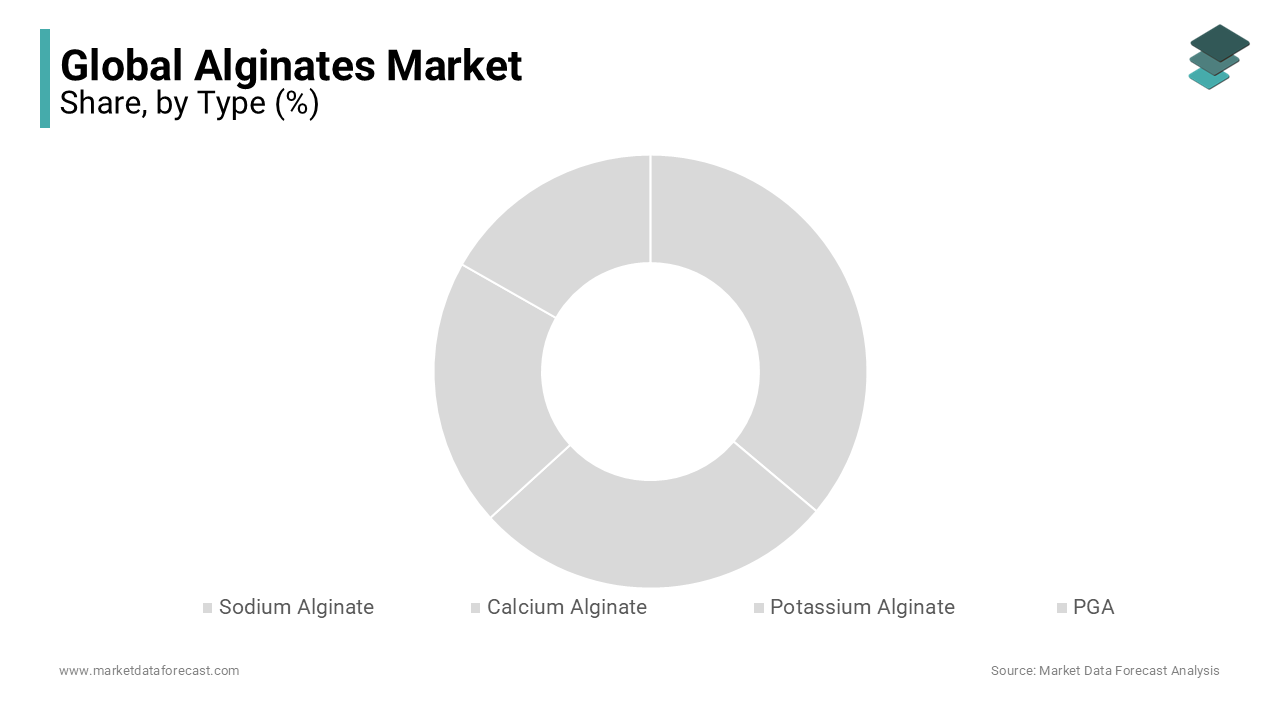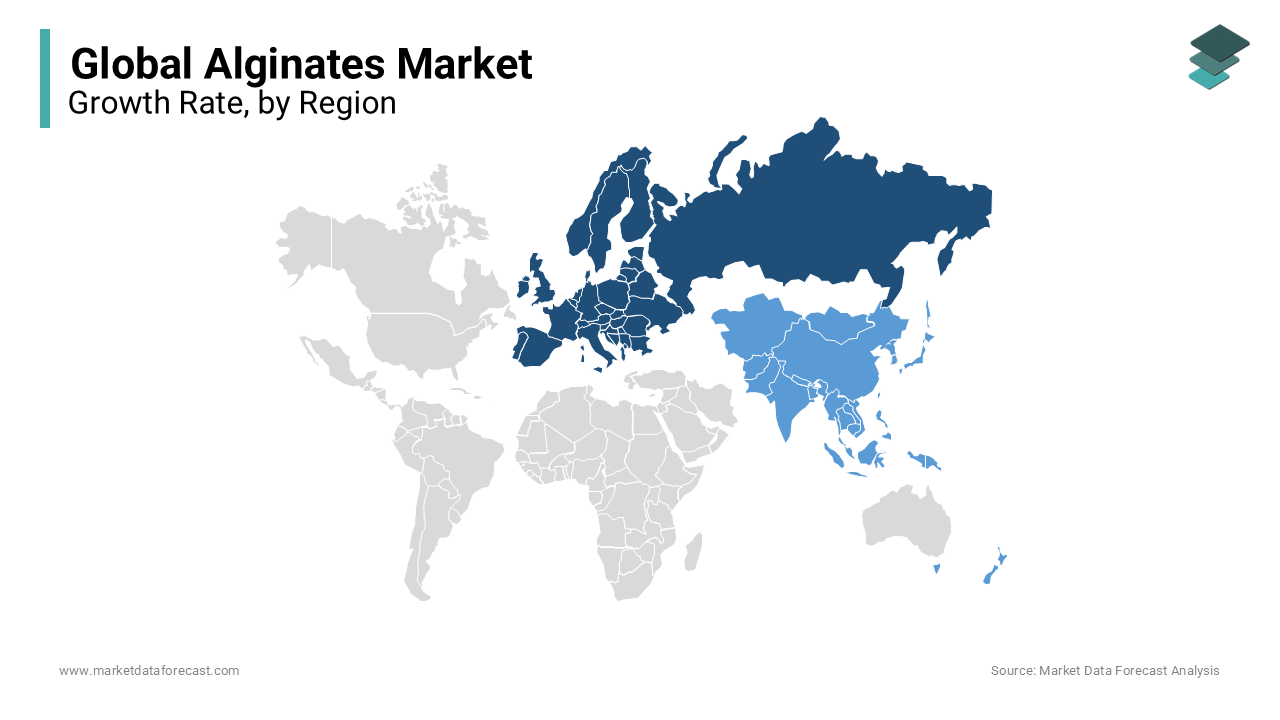Global Alginates Market Size, Share, Trends, & Growth Forecast Report - Segmented By Type (Sodium Alginate, Calcium Alginate, Potassium Alginate, PGA, Others), Application (Food & Beverage, Industrial, Pharmaceuticals, Others), And Region (North America, Europe, Asia Pacific, Latin America, And Middle East & Africa) - Industry Analysis (2025 To 2033)
Global Alginates Market Size
The global Alginates Market size was calculated to be USD 442.59 million in 2024 and is anticipated to be worth USD 629.94 million by 2033 from USD 460.29 million In 2025, growing at a CAGR of 4% during the forecast period. The market is supposed to show significant growth as the use of products like thickener and gelling agents increases.

Alginate or alginic acid is extensively distributed in the cell walls of brown algae and mixes with water to form viscous gums. It has other functional properties such as thickeners, the ability to form gels, and uses to form sodium and calcium films. Alginate has numerous applications in the food, dyeing, textile, printing, pharmaceutical, and cosmetic industries. In addition, it is used as a welding rod and as a binder for feed production. Europe and Asia Pacific dominate the bulk alginic acid market during the forecast period. Due to the unique properties of alginic acid, it is used in many foods like ice cream, jellies, dressings, instant noodles, beer, dairy drinks, etc. Brown algae contain mixed alginate, the basic raw material used in the manufacture of products. The color is white to tan. Usually, it is sold in the form of filaments and granules. It is quickly absorbed by water and is used as a useful additive in the manufacture of textiles and paper, as well as in dry products as weight loss aids. This product is a colloidal substance obtained from natural algae, which is commonly used in processed foods. In the food industry, the demand for alginic acid salts is expected to be driven by the high-quality gelation that products provide.
MARKET DRIVERS
Increased consumption of foods such as ice cream, beer, and yogurt is expected to increase market demand for products in the food and beverage industry.
The use of products in the food and beverage industry is permitted to meet the needs of major regulatory agencies, including the FDA and the European Commission. Due to population growth, growth in the food and beverage industry, primarily in the Asia Pacific region, is expected to drive demand for products in the region. In addition, high product adoption by companies in the application industry is expected to drive growth. The medicinal characteristics of this product are vital in healing wounds and the treatment of infections and other diseases, driving the alginate market in most developing countries. The main market drivers influencing market demand for alginic acid arise from food and beverage manufacturers due to functional properties such as thickeners, gelling agents, emulsifiers, stabilizers, and film-forming features. The reason for the growing demand in the food industry is one of the safest food additives in the food industry and is derived from FAO / WHO-certified natural algae. Food and beverage manufacturers primarily used alginic acid as a thickener and texture improvement. Meanwhile, the demand from the textile industry is increasing, as it is mainly used to print, design and dye cotton and jute fabrics.
The main factors driving the growth of the global alginates market include the growing demand from various sectors, especially food and textiles.
The textile industry, including industry, assembly applications, increased industrialization, increased end-user awareness, continuous development, and innovation, is based on the realization of processes such as dyeing, printing, and fabric design in cotton and jute. In addition, it has been applied as a binder to repair rods and as another factor to complement the growth of the alginate market in the manufacture of animal feed. As the application of products in the bakery and confectionery sector increases, it is expected to lead the growth of the market in the next 8 years. The adoption of emulsifiers in salad dressings, peanut butter, margarine, chocolate, and frozen desserts is anticipated to fuel demand for products as emulsifiers in the coming years. Because there are many suppliers on the market, the bargaining power of the supplier is low. The growth of innovation in food products to integrate natural ingredients and the growing demand for health and wellness products are new opportunities for the alginate and derivatives markets.
MARKET RESTRAINTS
On the other hand, the possible side effects of alginic acid, such as the expensive cultivation of brown algae and bloating, are likely to slow down the global alginates market.
However, this product will gain great popularity in various sectors due to its various applications. The rise in the call for seaweed and carrageenan gum is anticipated to impede the availability of raw materials.
REPORT COVERAGE
|
REPORT METRIC |
DETAILS |
|
Market Size Available |
2024 to 2033 |
|
Base Year |
2024 |
|
Forecast Period |
2025 to 2033 |
|
CAGR |
4% |
|
Segments Covered |
By Type, Application, And Region |
|
Various Analyses Covered |
Global, Regional and Country Level Analysis; Segment-Level Analysis; DROC; PESTLE Analysis; Porter’s Five Forces Analysis; Competitive Landscape; Analyst Overview of Investment Opportunities |
|
Regions Covered |
North America, Europe, APAC, Latin America, Middle East & Africa |
|
Market Leaders Profiled |
Ashland Inc., Brenntag AG, Cargill Inc., Dohler Group, FMC Corporation, Dastech International Inc., E.I. DuPont De Nemours and Company, Kimica Corporation, Dow Chemical Company, and Penford Corporation |
SEGMENTAL ANALYSIS
By Type Insights

The sodium alginate segment accounted for 60.8% of the global market share in 2024. The domination of sodium alginate segment is majorly attributed to its extensive use in food, pharmaceuticals, and textiles. Sodium alginate is a key ingredient in molecular gastronomy for spherification and in wound care for its biocompatibility and gelling properties.
The PGA segment is expected to grow at the fastest CAGR over the forecast period owing to the increasing demand in the food and beverage industry, where it is used as an emulsifier and stabilizer. The rise in clean-label and natural food products has further boosted its adoption. PGA's unique functional properties, such as foam stabilization and texture enhancement, along with its compliance with regulatory standards, make it indispensable in modern food formulations. The segment's expansion aligns with the growing consumer preference for natural and sustainable ingredients.
By Application Insights
The food and beverage segment dominated the market by holding largest share of the global alginates market in 2024 due to the increasing demand for natural and clean-label ingredients. Alginates are utilized as thickeners, stabilizers, and gelling agents in products like ice cream, salad dressings, and canned foods. Their ability to enhance texture and extend shelf life makes them indispensable in food processing. The growing consumer preference for natural additives further propels the demand for alginates in this sector.
The pharmaceutical segment is anticipated to witness the highest CAGR over the forecast period. Alginates are employed in drug delivery systems, wound care products, and dental impressions due to their biocompatibility and versatility. The increasing demand for controlled-release formulations and advanced wound care solutions is driving this growth. Alginates' natural origin and functional properties align with the pharmaceutical industry's shift towards sustainable and effective materials.
REGIONAL ANALYSIS

By regional segmentation, the global alginates market is divided into North America, Latin America, Europe, Asia Pacific and the Middle East and Africa. The European market is expanding with the presence of large firms such as Algaia and Ceamsa, which participate in the manufacture of quality products. The rich raw materials from Chile and Norway help production. However, product prices in this area have been noticed to be high because of the rising demand for high quality among consumers. Due to the rapid development of the textile and food and beverage industries, product consumption in the Asia-Pacific region is expected to increase at an average annual rate of about 6%. The potential of alginate and derivatives used in the food processing industry and industry is foreseen to be the most crucial growth element in the Asia Pacific region. The region is also deemed to grow faster than developed areas in the future if this industry is explored. The supply of products in the pharmaceutical sector in this area is currently restricted because of low use in developing economies. However, this is likely to expand the market, which is expected to increase the consumption of products during the outlook period. The paper business in Central and South America is touted to witness significant consumption as alginates usage increases. In addition, demand for products from the food and beverage industry for the production of products, including gelatin, ice cream, and lactic acid beverages, is expected to fuel business expansion over the determined period.
KEY PLAYERS IN THE GLOBAL ALGINATES MARKET
Major Key Players in the Global Alginates Market are Ashland Inc., Brenntag AG, Cargill Inc., Dohler Group, FMC Corporation, Dastech International Inc., E.I. DuPont De Nemours and Company, Kimica Corporation, Dow Chemical Company, and Penford Corporation
RECENT HAPPENINGS IN THE MARKET
- In 2018, DuPont Nutrition and Health is investing in its alginic acid business for the JRS Group at its German headquarters, a specialist in functional additives and plant materials.
DETAILED SEGMENTATION OF GLOBAL ALGINATES MARKET INCLUDED IN THIS REPORT
This research report on the global Alginates Market has been segmented and sub-segmented based on type, application, & region.
By Type
- Sodium Alginate
- Calcium Alginate
- Potassium Alginate
- PGA
- Others
By Application
- Food & Beverage
- Industrial
- Pharmaceuticals
- Others
By Region
- North America
- Europe
- Asia Pacific
- Latin America
- Middle East and Africa
Frequently Asked Questions
1. What factors are driving the growth of the alginates market?
The growth of the alginates market is primarily driven by the increasing demand for natural and sustainable ingredients in various industries, the growing awareness regarding the health benefits of alginates, and their wide range of applications in food, pharmaceuticals, and other sectors.
2. What are the key challenges faced by the alginates market?
Some challenges the alginates market faces include fluctuations in seaweed availability due to environmental factors, pricing volatility, competition from alternative hydrocolloids, and the need for continuous research and development to expand their applications.
3. What is the future outlook for the alginates market?
The alginates market is expected to witness steady growth in the coming years, driven by increasing demand from industries such as food and pharmaceuticals, growing consumer preference for natural ingredients, and ongoing research to develop innovative alginate-based products.
Related Reports
Access the study in MULTIPLE FORMATS
Purchase options starting from $ 2500
Didn’t find what you’re looking for?
TALK TO OUR ANALYST TEAM
Need something within your budget?
NO WORRIES! WE GOT YOU COVERED!
Call us on: +1 888 702 9696 (U.S Toll Free)
Write to us: [email protected]